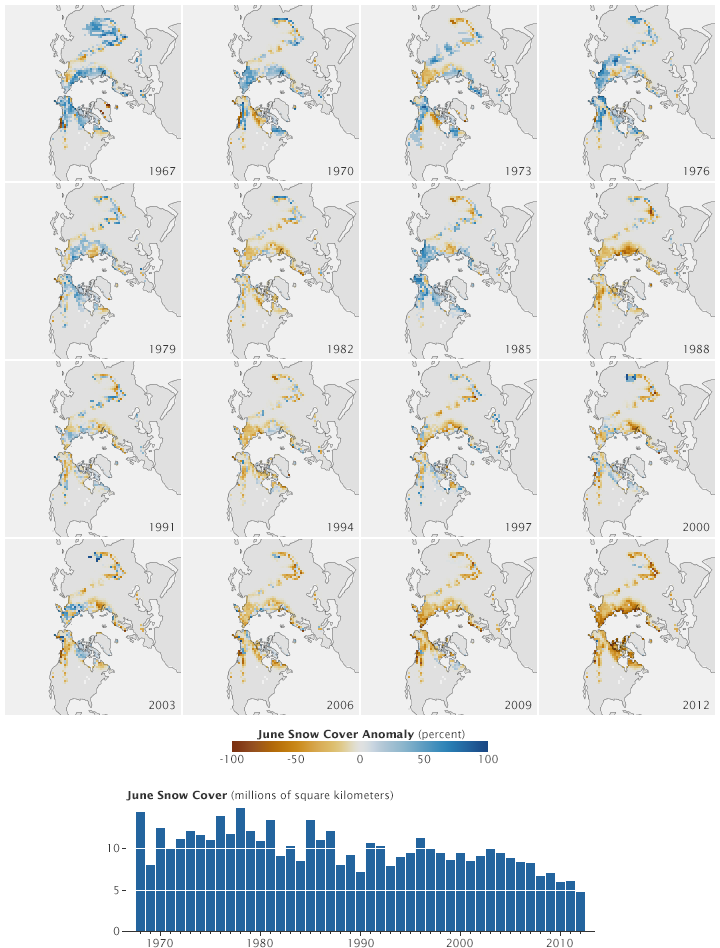


In the high latitudes of the Northern Hemisphere, snow typically covers the land surface for nine months each year. The snow serves as a reservoir of water, and a reflector of the Sun’s energy, but recent decades have witnessed significant changes in snow cover extent. Studies of snow cover published in Geophysical Research Letters and the Arctic Report Card: Update for 2012 found that, between 1979 and 2012, June snow cover extent decreased by 17.6 percent per decade compared to the 1979–2000 average.
The maps on this page show June snow cover extent anomalies for every third year from 1967 through 2012. Each June’s snow cover is compared to the 1971–2000 mean. Above-average extent appears in shades of blue, and below-average extent appears in shades of orange. Toward the beginning of the series, above-average extents predominate. Toward the end of the series, below-average extents predominate.
The graph shows June snow cover in millions of square kilometers from 1967 through 2012, and the overall decline in snow cover is consistent with the changes shown in the maps. The graph and maps are based on data from the Rutgers University Global Snow Lab.
The snow-cover study authors, Chris Derksen and Ross Brown, found an overall decline in snow cover from 1967 through 2012, and also detected an acceleration of snow loss after the year 2003. Between June 2008 and June 2012, North America experienced three record-low snow cover extents. In Eurasia, each successive June from 2008 to 2012 set a new record for the lowest snow cover extent yet recorded for that month.
Previous research identified a link between rising air temperatures and shrinking snow cover, so Derksen and Brown were not surprised to see an overall loss of snow, “But we were surprised at the continued broken records of June Arctic snow cover extent over the past five years,” says Brown. “Arctic spring snow cover typically fluctuates over cycles of about three to four years so you don’t expect to see sequences of decreasing snow cover persisting through these natural cycles.”
As with sea ice, declining snow cover extent means decreasing albedo. The overall “whiteness” of an object determines how much sunlight it reflects back into space. Snow has very high albedo, reflecting up to 90 percent of the sunlight it receives. As snow cover declines, dark soils and vegetation absorb more of the Sun’s energy. The Geophysical Research Letters study pointed out that declining snow cover raises ground temperatures and increases the thickness of the active layer—the uppermost layer of permafrost that thaws each summer. When organic material in thawing permafrost decomposes, it can release methane, a potent greenhouse gas when released to the atmosphere.
Anticipating future changes in Arctic snow cover poses challenges for researchers. “Changes in fall snow cover are complicated because the longer open-water season provides additional moisture for increasing snowfall,” Brown says. “As for future snow cover, climate is strongly influenced by interannual variability over periods of five to ten years, so that time range is hard to predict. But global climate models show the rate of Arctic snow cover decline speeding up over the long term.”
Image by Robert Simmon, using data from the Rutgers University Global Snow Lab. Caption by Michon Scott.